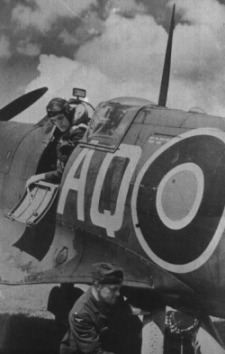|
From
'Spitfire The Canadians', Robert Bracken, Boston
Mills Press.
Jan Zurakowski, 234, 609 Squadrons (Avro Arrow test pilot) |
||||
|
During 1940 I was in England with Keith Ogilvie, or "Ogi" as we called him, in 609 Fighter Squadron. Earlier, I was with Stew Young in 234 Squadron. At that time, I was a pilot officer, and so I flew any aircraft that was available. According to my logbook, I carried out eight sorties on Spitfire Mark I No. 4182 and 13 sorties on No. 3191. From August 14, 1940, to September 11, when 234 Squadron operated from Middle Wallop near Salisbury, we suffered such heavy losses that what remained of the squadron was moved back to St. Evel (Cornwall), and only one section was fully operational. In October I was posted back to the Middle Wallop RAP station and joined 609 Squadron, where Ogi was my section leader. My first Spitfire flight was at No. 5 Operational Training Unit at Aston Down, on July 24, 3 1940. On the second flight, I was instructed and authorized to do "acrobatic." Ten days later, I was posted to an operational squadron. After my first flight there, with a bit of aerobatics over our airfield, I was called to the station commander, who furiously explained to me that to do aerobatics on a Spitfire, one needed 50 hours' experience on the type, plus written permission from the station commander. My poor English (Polish was my first language) and the evidence in my logbook that I was cleared for aerobatics saved my skin. One problem with aerobatics on the Spitfire was in spinning. The proper technique for spin recovery was described in the Pilot's Notes, though spinning was not recommended. I determined that it was not possible to stop a spin in exactly the required direction. Training did not improve the situation. I was disappointed because on the old Polish PZI Xl fighter I could stop, after any number of spin turns, in the exact desired direction. I later discovered that probably the only time a pilot could be faster than a flying Spitfire was in bailing out of the aircraft in a spin. I discovered this during a sortie on August 24, 1940. I was attacking a formation of 10 17 bombers that were on a bombing run of South-hampton harbour After my attack, I made the error of climbing to join the squadron. Some of the escorting Me 109s managed to put a few cannon shells into my Spitfire. I lost control of elevator and rudder. My Spitfire then went slowly into a turn, stalled, and ended up in a flat spin. |
 Having no controls, I had to bail out. At about 18,000 feet I slid open the canopy, climbed out of the cabin, and jumped. I soon found I was descending faster than the Spitfire, which was spinning above my head. I was afraid to pull the rip cord to open the chute because that would have slowed me down, risking a collision with my spinning Spitfire. The ground was approaching fast, and when I could distinguish a man standing in a field with a gun, I decided to pull the rip cord. It was now or never! My parachute opened immediately. My Spitfire just missed me and hit the ground with a bang. A few seconds later, I landed the field, next to the old man (from the Home Guard) who was armed with a double-barrel shotgun. He was badly shaken by the crash Suspecting that I might be a German, he asked me if I spoke English. Since my English was poor, I decided to remain quiet. I tried show him my RAF identity card, but his hands were shaking so violently that he could not take it. I decided to start packing my chute, and a British army officer arrived and cleared the situation. A Spitfire's vertical speed in a flat spin is fairly low, so the damage to my Spitfire on impact with the ground was not severe. The main engine mounting failed and there was evidence of two gunshots (probably 20 mm calibre) in the rear fuselage tail junction and one in the port wing. I learned later on that day, seven RAF and seven German aircraft crashed on the Isle of Wight. The spot where I landed was not too far away from the spot where, on August 15, an ME110 was badly damaged by my attacks and crash-landed. The pilot was killed, and the uninjured gunner was later a prisoner of war in a camp in Canada. Go to Page Two
|
|||
|
Copyright © 1997 - 2000 COMBATSIM.COM, INC. All Rights Reserved. Last Updated December 28th, 1999 |
||||
